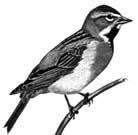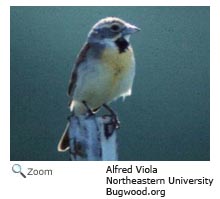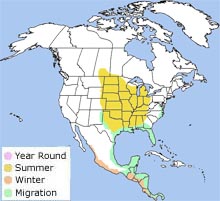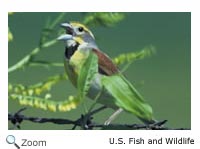Dickcissel - Spiza americana |
|||||||||||
Description
Range |
Habitat
Diet
The dickcissel forages on the ground for seeds and insects. In the winter, dickcissels feed in flocks and are considered pests by farmers. Life CycleThe female lays 3-5 eggs in a nest in the grass or in a bush close to the ground. The eggs hatch in 13-15 days and the chicks fledge when they are 9-10 days old. BehaviorThe dickcissel was once a common bird in the farmlands of the eastern United States. There are still small, isolated populations found on the east coast. |
||||||||||
Audio Credit: xeno-canto.org Mike Nelson |
|||||||||||



 The dickcissel is found in the central United States from North Dakota south to Texas and east to Ohio and Tennessee and Alabama. It winters from southern Mexico to South America.
The dickcissel is found in the central United States from North Dakota south to Texas and east to Ohio and Tennessee and Alabama. It winters from southern Mexico to South America. 